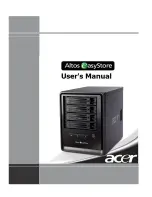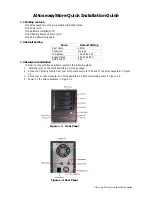
Modem and Flow Control Operation
A-12
893-826-A
The server determines when the type ahead buffer is “too full” by determining
the size of the unfilled portion of the type ahead buffer. This size is compared to
two thresholds. The first threshold is reached when there is space for 32
characters or the buffer is 80 percent full, whichever is greater. When a
character is placed in the type ahead buffer after this threshold is reached, the
port asserts flow control to inform the device to stop transmitting. The second
threshold is reached when there is space for 16 characters or the buffer is 90
percent full, whichever is greater. When a character is placed in the type ahead
buffer when this second threshold is reached, the port asserts flow control for
each additional character received. Recognition of XON/XOFF flow control
assertion or deassertion to the server can take up to 9 character times.
The effect of these thresholds is most notable when the port is using XON/
XOFF flow control. In this case, an XOFF character is sent after the port
receives a character when the first threshold is reached. If the buffer keeps
filling, then each character received after the second threshold is reached will
cause the port to send an XOFF character to the device for each character it
receives. No XOFF is sent for characters that are received between the time the
first threshold is reached and the second threshold is reached.
The operation of flow control when the port is transmitting (when the PORT
OUTPUT FLOW CONTROL characteristic is set to ENABLED) is
considerably simpler than when the port is receiving. Regardless of the flow
control method, whenever the attached device asserts flow control to tell the
port to stop transmitting, the port stops. Whenever the attached device tells the
port to start transmitting again, the port starts.
Finally, you can disable flow control. Without an active flow control
mechanism, however, data can be lost, occurring with data flow either into or
out of the port. Without flow control, the only mechanism that prevents data
loss at the server port is the type ahead buffer, and the only mechanism that
prevents data loss at the device is some similar type of buffer or the speed at
which the device is able to absorb data.
Hardware Flow Control Operation Using the Modem Control Signal Lines
When the FLOW CONTROL characteristic is set to CTS or DSR (hardware
flow control is selected), modem signals are used in place of XON and XOFF
to control the flow of data. Only one type of hardware flow control can be used
at a given port.
When using hardware flow control, the server observes the DCD or CTS
modem control signal line and manipulates the DTR or RTS modem control
signal lines. To stop data flow from the device to the port, the port deasserts the
DTR or RTS signal. To start data flow, the port asserts DTR or RTS. Similarly,
the port monitors DCD or DSR. When the port observes that the device has
deasserted DCD or DSR, the port will stop transmitting. When the port detects
that the device has asserted DCD or DSR, the port will start transmitting again.
Содержание 3395A
Страница 8: ...viii 893 826 A ...
Страница 10: ...x 893 826 A ...
Страница 14: ...Preface Preface xiv 893 826 A ...
Страница 34: ...Introducing the Communication Server 1 20 893 826 A ...
Страница 58: ...Setting Up Basic Modem Applications 3 14 893 826 A ...
Страница 84: ...Serial Line Internet Protocol SLIP 5 8 893 826 A ...
Страница 98: ...Setting Up ARAP 6 14 893 826 A ...
Страница 112: ...Model 3395A Server Support for the Xremote Protocol 7 14 893 826 A ...
Страница 130: ...Using CCL Scripts 8 18 893 826 A matchread 20 LABEL 65 exit 0 Add Model 3395 extensions immediately after this line ...





































